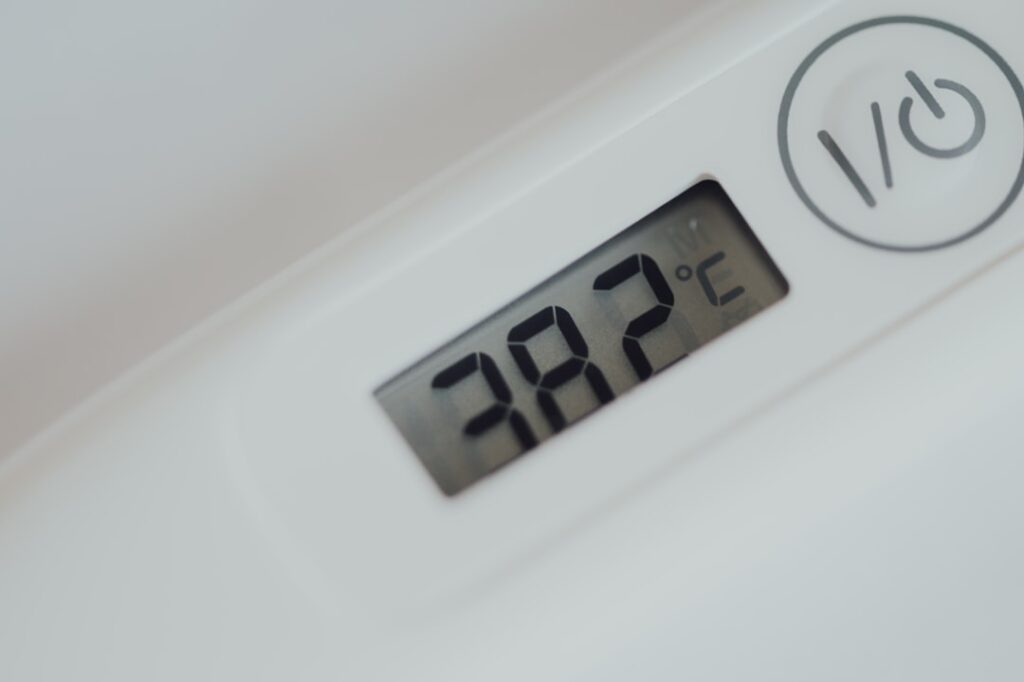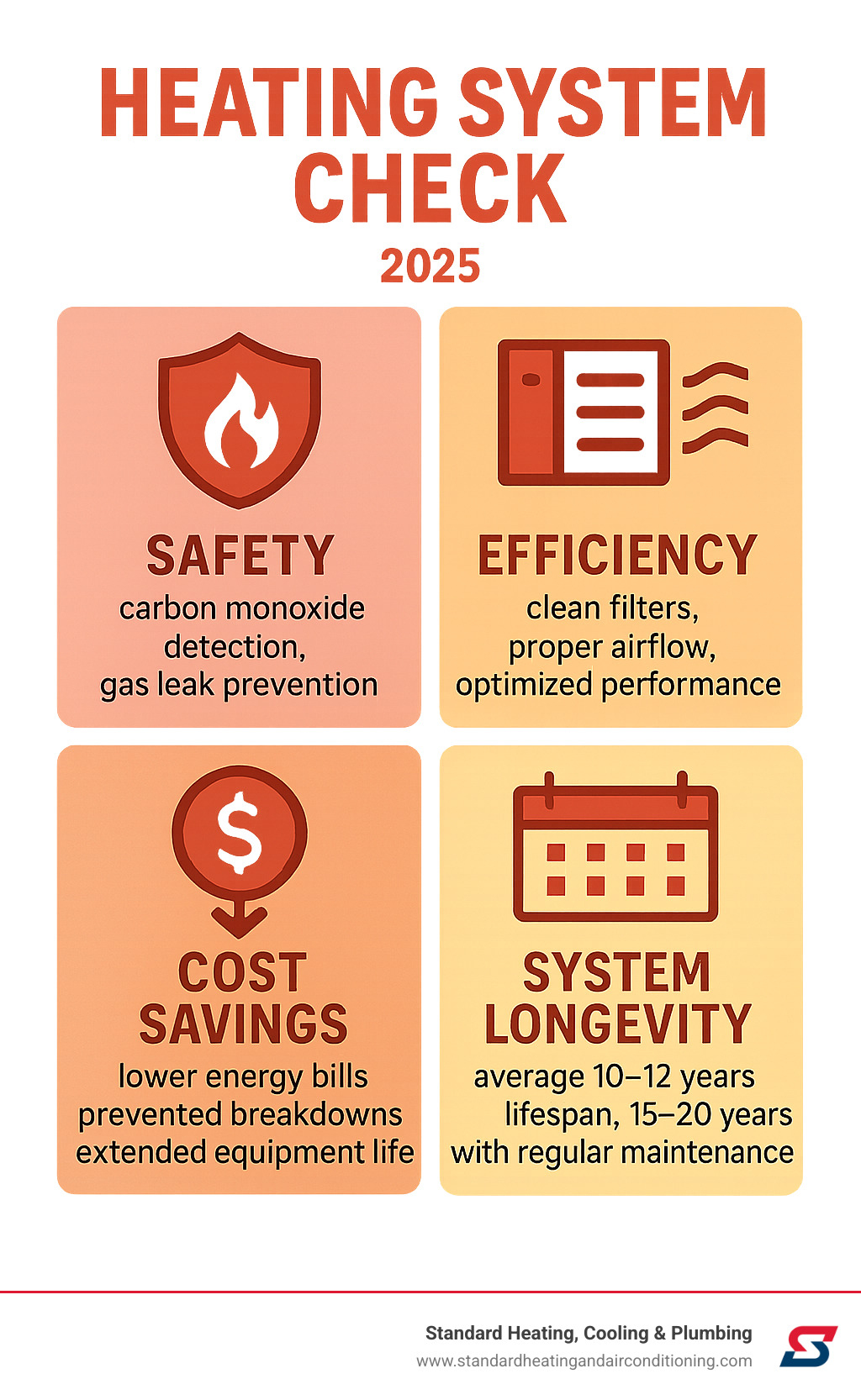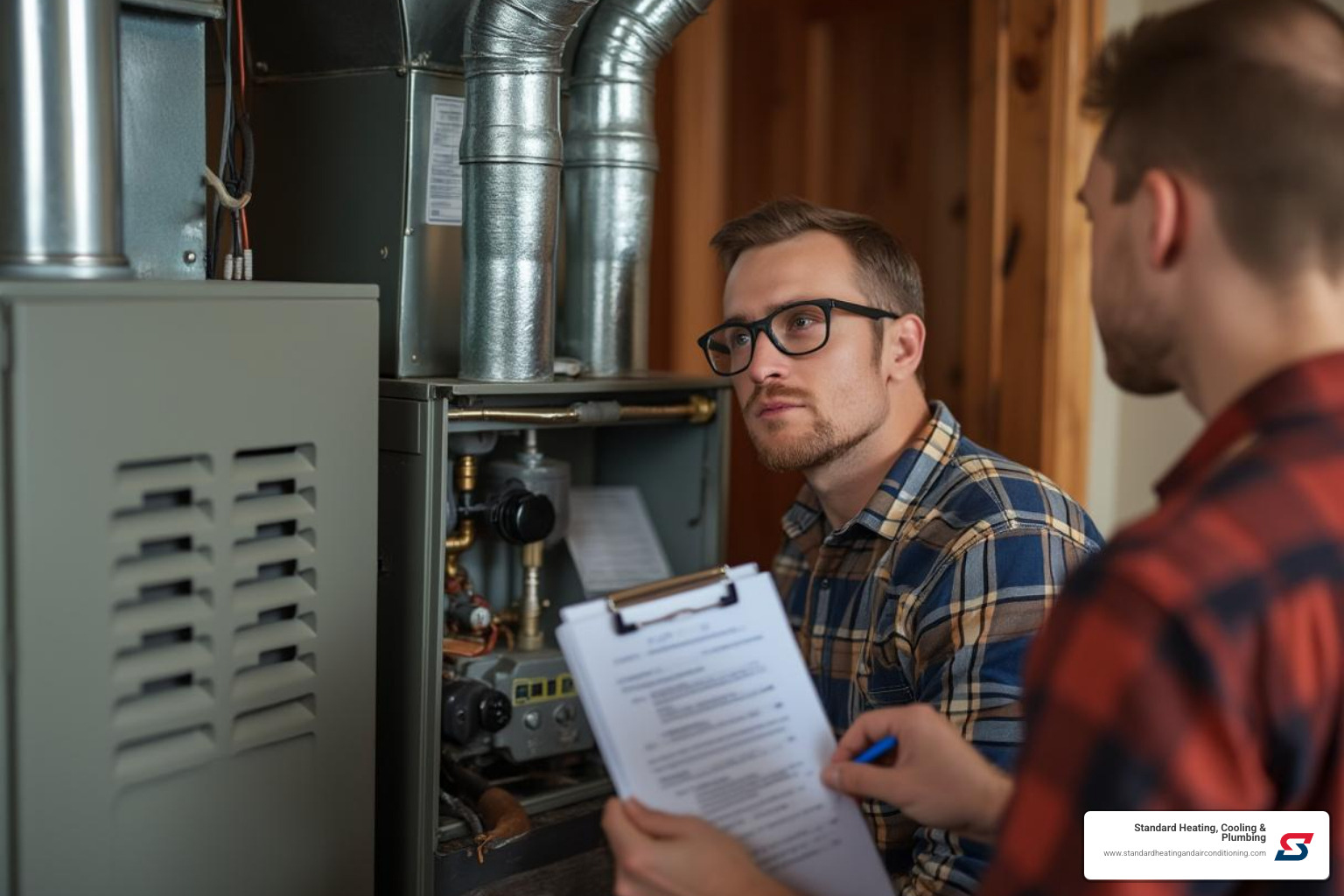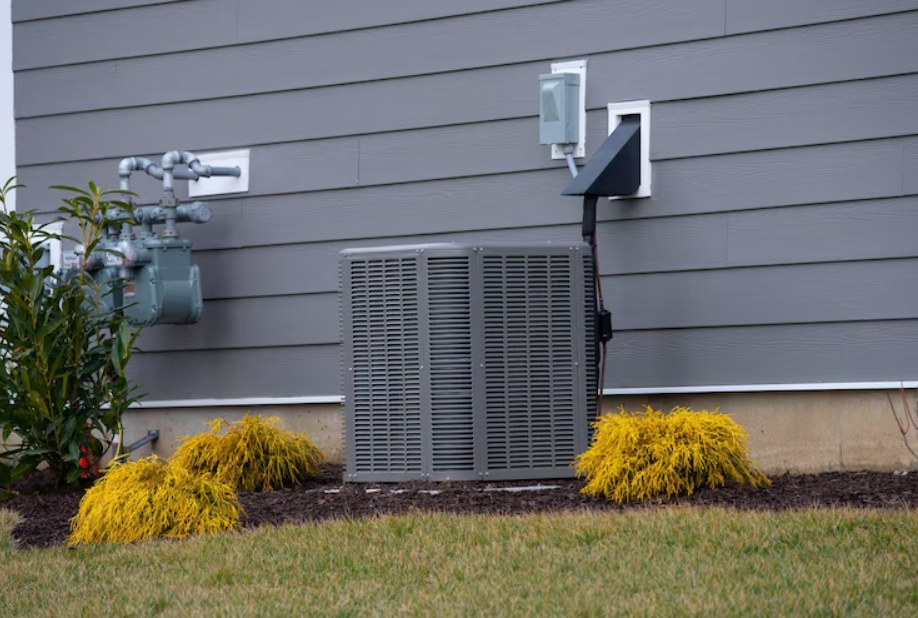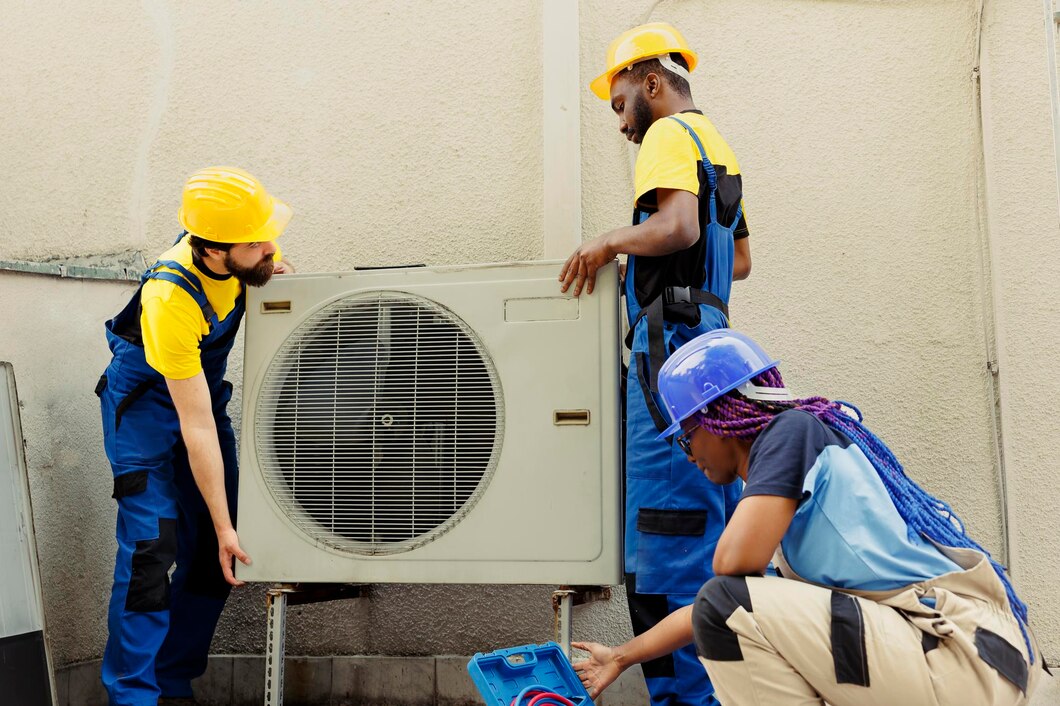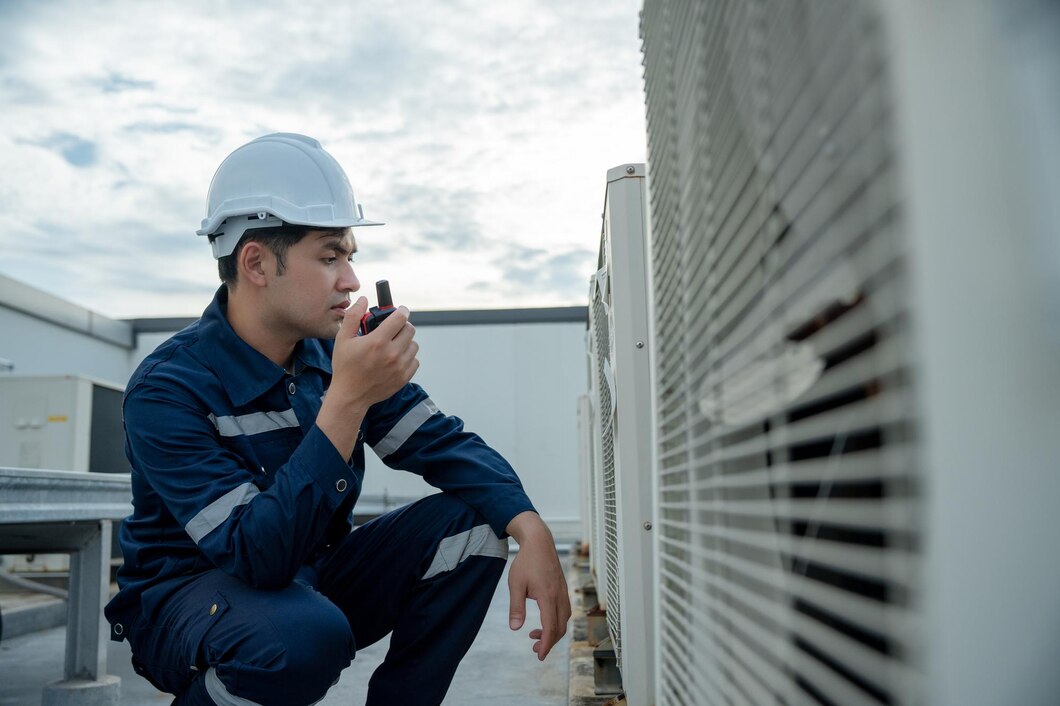Why a Heating System Check is Essential Before Winter Strikes
When the first cold days hit Birmingham, a pre-season heating system check is your best defense against scrambling for emergency repairs. An annual check-up catches small problems before they become expensive emergencies, ensuring your system is ready when you need it most.
Essential heating system check tasks:
- Inspect and replace air filters to prevent efficiency loss.
- Test thermostat settings and battery function.
- Clear vents and registers of obstructions.
- Visually inspect the unit for damage or leaks.
- Check safety components like carbon monoxide detectors.
- Verify proper airflow throughout your home.
A well-maintained system runs more efficiently and safely. For example, airflow problems can reduce efficiency by up to 15%, and improperly operating gas connections are a serious fire hazard. With proper care, many heaters can last 15 to 20 years. This guide will walk you through basic checks you can perform yourself and help you know when to call a professional.
Why Annual Maintenance is Non-Negotiable
Imagine it’s the first cold night in Birmingham, and your heater fails. This common scenario is almost always preventable with an annual heating system check. Just as your car needs regular oil changes, your heating system requires professional attention to run reliably and efficiently.
Improved Efficiency and Lifespan
Annual maintenance directly impacts your wallet. A well-tuned system uses less energy, lowering your utility bills. A clean filter alone can prevent significant cost increases, while correcting airflow problems can boost efficiency by up to 15 percent. Regular tune-ups also prevent major breakdowns and can help your system reach its full 15- to 20-year lifespan, protecting your investment.
Safety and Health
This isn’t just about comfort—it’s about protecting your family. Unmaintained gas or oil systems pose serious risks. A cracked heat exchanger or faulty ventilation can leak deadly, odorless carbon monoxide (CO) into your home. Carbon monoxide prevention is a key part of a professional check-up. Technicians inspect the heat exchanger, test ventilation, and ensure the system is burning fuel cleanly and safely.
Air Quality and Warranty Protection
A clean system circulates cleaner air, reducing the dust and allergens in your home. Furthermore, most manufacturers require proof of annual professional service to keep your warranty valid. Skipping these check-ups could leave you paying the full price for repairs that should have been covered.
Neglected HVAC equipment is the primary cause of system failures. An annual heating system check is essential for safety, efficiency, and peace of mind.
Want to learn more? Check out our articles on the Dangers of Neglecting Your HVAC System and the Top 5 Reasons to Get a Fall Furnace Tune-Up.
Your Complete DIY Heating System Check
Before cold weather arrives, you can perform a preliminary heating system check to identify simple issues. Think of it as a pre-flight checklist for your home’s comfort.
Safety First: Precautions for Your Heating System Check
Before you begin, prioritize safety:
- Turn Off Power: Shut off power at the circuit breaker and the dedicated switch on or near the unit.
- Turn Off Gas (If Applicable): For gas furnaces, turn the shut-off valve on the gas line to the “off” position.
- Consult Your Manual: Your user manual has model-specific instructions and safety warnings.
- Check CO Detectors: Ensure you have functional carbon monoxide detectors, especially near fuel-burning appliances. Test them monthly. For placement tips, see this guide on carbon monoxide detectors.
Step 1: Inspect and Change the Air Filter
This is the most impactful DIY task. A clogged filter restricts airflow, forcing your system to work harder.
- Locate and Inspect: Find the filter in the return air duct or furnace unit. If it’s clogged with dirt and you can’t see light through it, it’s time for a change. A dirty filter can increase energy costs and damage your equipment, leading to early failure.
- Replace: Note the size on the filter’s frame, buy a matching replacement, and slide it in with the arrows pointing toward the furnace. Inspect filters monthly and replace them every 1-3 months, depending on your home’s conditions (pets, allergies, etc.). A clean filter improves efficiency and your home’s air quality. Learn more in our article on Furnace Repair for Air Quality.
Step 2: Check Your Thermostat
Your thermostat is the system’s brain. Ensure it’s set to “Heat” and the fan is on “AUTO” to avoid circulating unheated air and wasting energy. Test it by turning the temperature up a few degrees to see if the heat kicks on. If the display is blank, try replacing the batteries. For more tips, see our article on How to Save Money on Your Heating Bills.
Step 3: Clear and Inspect Vents and Ductwork
Warm air needs a clear path. Walk through your home and ensure all supply and return vents are open and not blocked by furniture, rugs, or drapes. Visually inspect any exposed ductwork in your basement or attic for obvious gaps or tears, which waste energy. You can temporarily seal small leaks with HVAC-specific duct tape. For more help, read our guide to Fix Uneven Heating Issues.
Step 4: Visually Inspect the Unit
With the power still off, take a look at the unit itself.
- Clear the Area: Maintain at least 3 feet of clearance around your furnace or heat pump, removing any clutter or flammable materials.
- Check Components: Ensure the furnace blower door is secure. For high-efficiency furnaces and heat pumps, check that the condensate drain line isn’t clogged, which can cause water damage or system shutdown. Clogged condensate drains can contribute to bacteria and mold growth.
- Look for Trouble Signs: Visually check for excessive soot, rust, or cracks on the burners and heat exchanger—these are serious issues requiring a professional. After restoring power, listen for unusual noises (grinding, banging) and note any electrical or chemical smells, which are red flags. For more help, see our Winter Heater Troubleshooting guide.
Maintenance for Different Heating Systems
Different heating systems have unique maintenance needs. Understanding your system type helps you perform a more targeted heating system check and know what to expect from a professional.
| System Type | Basic DIY Checks (Beyond Filters/Thermostat/Vents) | Key Professional Checks |
|---|---|---|
| Furnace | Clear unit area, inspect condensate drain, look for soot/rust on burner (visual only), listen for noises, check pilot light (if applicable). | Gas/Oil connections, gas pressure, burner combustion, heat exchanger integrity, igniter/pilot assembly, electrical connections, fan motor, carbon monoxide testing. |
| Heat Pump | Clean outdoor unit (debris, fins), ensure proper airflow around unit, listen for unusual noises. | Refrigerant levels, compressor, outdoor coil cleaning, reversing valve, electrical components, defrost cycle, auxiliary heat strips. |
| Boiler | Check pressure gauge (12-15 psi cold), look for leaks around pipes/radiators, check water level (steam boilers). | Pressure relief valve, expansion tank, circulator pump, burner assembly, flue pipe, water quality, zone valves, venting. |
Gas & Oil Furnaces
Common in Birmingham, furnaces heat air and distribute it via ducts.
- Ignition System: Older furnaces may have a pilot light that needs to be lit. Newer models use an electronic ignition. If your furnace runs but produces no heat, a dirty igniter could be the cause. Improperly operating gas (or oil) connections are a fire hazard.
- Burners and Fuel Lines: A professional will inspect the burners for clean combustion. Excess soot reduces your system’s efficiency and can signal a safety issue. If you smell gas, turn off the supply immediately and call for help. For more on this, see our article on Common Furnace Ignition Problems.
Heat Pumps
Heat pumps provide both heating and cooling, making them popular in areas like Hoover and Vestavia Hills.
- Outdoor Unit: Keep the area around your outdoor unit clear of leaves, grass, and other debris. Trim shrubs back at least two feet to ensure proper airflow. You can gently rinse the fins with a hose, but avoid using a pressure washer.
- Auxiliary Heat: Most heat pumps have auxiliary electric heat strips for very cold weather. You can test this function on your thermostat. A professional will check this along with the reversing valve, which switches the unit between heating and cooling. For more tips, see our guides on Heat Pump Maintenance Tips and how to Identify and Fix Heat Pump Noises.
Boilers
Boilers provide radiant heat through hot water and radiators, common in older homes.
- Pressure and Leaks: Check the pressure gauge on a hot water boiler; it should read 12-15 psi when cold. Constantly needing to add water indicates a leak. Inspect pipes and radiators for leaks or corrosion.
- Radiators and Noises: Bleed trapped air from radiators to ensure they heat properly. Gurgling or banging noises can indicate air in the system or a problem with the circulator pump. For more information, explore this guide on boiler systems.
When to Call a Professional
While a DIY heating system check is a great first step, some tasks require the specialized tools and training of a professional. Attempting complex repairs can be unsafe and may cause more damage. With 85 years in the business, we know when a situation requires a certified technician.
Call a professional if you encounter any of these warning signs:
- Serious Safety Hazards: If you smell gas, notice strong burning or chemical odors, or see visible cracks on the heat exchanger, call for immediate service. Improperly operating gas or oil connections are a fire hazard.
- Loud or Unusual Noises: Banging, grinding, or persistent squealing are cries for help from your system and should not be ignored.
- Ignition or Pilot Light Issues: A pilot light that is yellow or flickering (instead of a steady blue) can indicate incomplete combustion, which may produce carbon monoxide.
- Poor Performance: If your system is short cycling (turning on and off frequently), running constantly, or simply not producing heat, it’s time for a professional diagnosis.
- Rising Energy Bills: A sudden, unexplained increase in your heating costs often signals an efficiency problem within the system.
- Water Leaks: Any water pooling around your furnace, boiler, or air handler is abnormal and needs to be addressed to prevent rust and water damage.
- Advanced Age: If your system is over 15 years old, it’s more prone to failure. A professional can help you decide whether a repair or replacement is the more cost-effective option.
When heating emergencies strike, you need help fast. For guidance on immediate concerns, check out our article on What Should You Do If Your Heating Goes Out?. Your safety and comfort are our top priorities.
Frequently Asked Questions about Heating System Checks
With 85 years of serving the Birmingham area, we’ve answered countless questions about heating systems. Here are some of the most common.
How often should I get my heating system checked?
We recommend a professional heating system check once a year, every year. This is the industry standard and is often required by manufacturers to keep your warranty valid.
The best time to schedule your check-up is in the fall, ideally in September or October. This ensures any potential issues are found and fixed before you rely on your heat daily, and it helps you avoid the rush for emergency service on the first cold day of the season. For more on seasonal care, see our guide to a Spring HVAC Tune-Up in Homewood.
What is included in a professional heating tune-up?
A professional tune-up is a comprehensive inspection that goes far beyond a DIY check. Our certified technicians use specialized tools to perform key tasks, including:
- Cleaning internal components like burners, flame sensors, and heat exchangers to improve efficiency.
- Testing safety controls and checking for carbon monoxide leaks to ensure safe operation.
- Tightening electrical connections to prevent system failures and improve longevity.
- Lubricating moving parts to reduce friction, lower energy use, and prevent wear.
- Measuring system performance, including airflow and temperature rise, to confirm it’s operating at peak efficiency.
Can regular maintenance really save me money?
Yes. Regular maintenance is an investment that pays for itself in three key ways:
- Lower Energy Bills: A clean, well-tuned system runs more efficiently, using less fuel to heat your home. Correcting issues like poor airflow can boost efficiency by up to 15%.
- Fewer Costly Repairs: Catching small issues during a tune-up is far cheaper than paying for an emergency breakdown in the middle of winter.
- Longer Equipment Life: Many heaters can last 15 to 20 years, but only if they’re taken care of properly. Proper maintenance helps your system reach its full potential lifespan, saving you thousands in premature replacement costs.
Conclusion
A thorough heating system check is your ticket to a warm, safe, and comfortable winter in Birmingham. By performing simple DIY tasks and knowing when to call for professional help, you can ensure your system is ready for the cold.
Regular maintenance prevents the stress of a sudden breakdown and protects your family from safety hazards like carbon monoxide. It also saves you money on energy bills and extends the life of your equipment.
At Standard Heating, Cooling & Plumbing, we’ve been keeping Birmingham families comfortable for 85 years. Our family-owned business combines generations of experience with modern technology to provide reliable service. Our certified technicians know exactly what to look for, whether you’re in Hoover, Homewood, or anywhere else in our service area.
Don’t leave your comfort to chance. A professional inspection provides the ultimate peace of mind. Our team will catch issues you might miss and ensure your system is ready for winter.
Ready to schedule your tune-up? Schedule your furnace repair in Birmingham, AL today! Your future cozy self will thank you.

